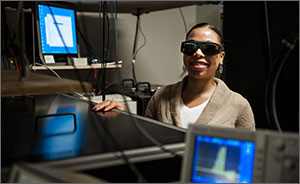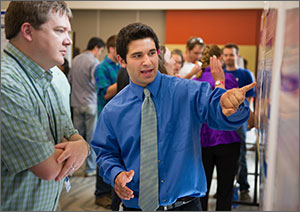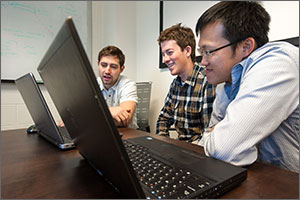NREL Looks for Star Science Students
 Enlarge image
Enlarge image
NREL postdoctoral researcher Barbara Hughes works on time-resolved photoluminescence
spectroscopy in the Laser Lab at NREL's Solar Energy Research Facility as part of
the Research Participant Program.
Credit: Dennis Schroeder
Barbara Hughes grew up and attended high school less than 20 miles from the Energy Department's National Renewable Energy Laboratory (NREL) and earned her doctorate at the nearby University of Colorado (CU) in Boulder—so it may not be too surprising that she has gravitated to the lab.
She's currently in NREL's Research Participant Program (RPP) pursuing battery research—her second stint at the lab. The RPP offers opportunities for undergraduates, graduate students, and postdoctoral researchers to work at the lab under the mentorship of experts in solar and wind energy, biofuels, building technologies, and other fields.
Earlier, while at CU, Hughes worked part time with renowned NREL scientist Art Nozik on quantum dots and an innovative approach to boosting the efficiency of photovoltaic solar cells. Realizing that the more she learned across disciplines, the more marketable she would be in her field, Hughes applied last year for a highly competitive RPP postdoc position that gave her the opportunity to join a lithium-ion battery project. She's investigating fundamental charge transfer in electrode materials and her postdoctoral research is supported by the U.S. Department of Energy, Office of Science, Basic Energy Sciences, Materials Sciences and Engineering Division.
"So far, the RPP program has provided an invaluable opportunity to work in a new research area beyond the scope of my graduate work,"Hughes said. "NREL is a very friendly place," she added, "but when I was working with quantum dots, I didn't venture much out of that area. Now that I'm in batteries, I'm bridging the two fields, helping bring together scientists who otherwise wouldn't work together."
"People are very open if you come to them with ideas. The staff scientists here are so open to teaching you something new."
And those sorts of experiences are repeated again and again. From the lab's viewpoint, the RPP is a chance to bring in young scientists and engineers who:
- Show promise and are eager to learn
- Emerge from a competitive application process ready to contribute to an important project
- Can potentially propose a research project that intrigues NREL scientists or engineers.
"NREL recruits the brightest minds from university campuses through a competitive process," said Talent Management and Acquisition Manager Kim Gutierrez. "These students and recent graduates are able to work on cutting-edge research projects that will impact the world. They work hard for the opportunity to collaborate with world-renowned researchers at a national lab."
From the viewpoint of a young scientist or engineer, the RPP offers chances to:
- Work with world-class experts on ground breaking research that may yield patentable results
- Engage in innovative Energy Department initiatives
- Display their brainpower—and just as importantly, their collegiality and willingness to work as part of a team
- Work across disciplines, leveraging their skills in one area to become an important player in a bigger project
- Gain an edge for a job in industry or academia with access to more than 200 industry partners
- Potentially publish their work in peer-reviewed journals.
"The postdocs and interns may find career paths within NREL or build a career at other national laboratories, industry, or academia, carrying with them the advantage of having gained national lab experience," RPP and University Relations Coordinator Danelle Hutton said.
Internships are open to undergraduate and graduate students who are enrolled full-time in a U.S. college or university, have successfully completed at least the freshman year of school by May of the application year, and also plan to continue full-time enrollment the following fall term.
For postdoctoral researchers looking to participate in the laboratory's research and development programs, launch new areas of research, and even establish a base for ongoing collaborations, NREL's RPP can be an ideal fit. And both interns and postdocs can look for opportunities across the range of the lab's research centers, which include:
- National Bioenergy Center, a leading hub for biochemical engineering, microbiology, molecular biology, chemistry, and chemical engineering related to biomass and derived products
- National Center for Photovoltaic Research, recognized as a world leader in photovoltaic research, drawing upon physics, chemistry, materials science, and electrical and chemical engineering skills
- National Wind Technology Center, a primary global anchor for aerospace, mechanical and electrical engineering, and meteorology advancement
- Strategic Energy Analysis, which provides groundbreaking insights focused on technology, market, policy, and sustainability
Talent Shines at the Lab
 Enlarge image
Enlarge image
NREL Research Participant Program intern Robert Sebag, right, explains his research
poster to NREL Senior Scientist Todd Deutsch at an intern poster session. The session
gives interns the chance to share their research at NREL.
Credit: Dennis Schroeder
NREL seeks to attract the best and brightest for the various RPP programs. RPPs are often students with great potential right from NREL's backyard. Robert Sebag was just a sophomore at Colorado School of Mines when he started working 18 to 20 hours a week at NREL.
It doesn't give him much free time, but he's having too much fun to notice. He has been using mass spectrometry to track changes in oil molecular composition when pretreating algae under very specific conditions to see if there can be a quicker and more efficient way to extract oil from algae when making biofuels.
"It's been great. Everyone is very cheerful and helpful and on board to help you out," Sebag said. "Over time, you learn so much on the job—operating advanced equipment, creating and optimizing lab procedures, how to properly work in a professional environment, the dos and don'ts of lab work."
"So many techniques and lessons I have learned at NREL can be applied to a wide range of careers I intend on pursuing as a chemical engineer. Everyone at NREL is on board with helping advance my career. I consider myself very fortunate to be working with such talented individuals while gaining valuable experience in the professional world."
Hughes has also had an enriching experience. "I don't feel like I have one mentor. I feel like I have six. The cross-disciplinary conversations you can have with experts are just fantastic. What I've learned here—it has been just amazing."
Working Together
Chad Hotimsky spent the summer of 2013 as a Science Undergraduate Laboratory Intern at NREL's National Wind Technology Center, where he impressed quite a few research engineers.
"Chad did a great job for us last summer, so when we needed someone to get into the details of one of our projects, we thought of him," NREL Research Engineer Yi-Hsiang Yu said. Yu, fellow research engineer Michael Lawson, and NREL Research Fellow Robert Thresher are triple-teaming Hotimsky's research—and Hotimsky appreciates the time from his mentors.
"Anytime I need anything, I can get my questions answered," said Hotimsky, who is working on marine hydrokinetics. "If I ever don't have enough to do, I can go to them and get more work. I'm learning things to further my own career." Hotimsky hopes to find a job in industry next summer, partly because he wants to see how it compares to working in a national laboratory. "But I really love it here. This is definitely an option for a career."
Hotimsky is a senior at CU, where he is a resident advisor and in charge of his dormitory's sustainability program. His enthusiasm for renewable energy combined with his love of big structures—wind turbines, ski lifts, the bigger the better—led him to apply for an RPP undergraduate internship.
A Continuing Tradition
 Enlarge image
Enlarge image
NREL Research Participant Program intern Chad Hotmimsky, center, looks at simulations
of wave energy converters with research engineers Michael Lawson, left, and Yi-Hsiang
Yu, right. The two engineers are mentoring Hotmimsky at the National Wind Technology
Center (NWTC).
Credit: Dennis Schroeder
NREL's RPP programs continue allow experienced scientists to reach out to the next generation. NREL Senior Scientist Lieve Laurens, who herself was an RPP postdoc and is now making NREL her career, has mentored interns for several years and is now mentoring Sebag. "We're transferring knowledge to the students. They get that experience. But we get a lot in return."
Yu and Lawson remember when they were postdocs, counting on mentors to show them the ropes. "Mostly, I look at attitude" when deciding which candidates to bring into the RPP program, Yu said. "How do you approach a problem? Do you like to take on a challenge? Once they're here, I tell them to try to learn as much as possible when they're young. See what you like, and enjoy it.”
Brainpower is important, but it's not the only requisite trait, said researcher Michael Lawson. "I don't think anyone wants a genius who is difficult to work with and has trouble communicating," he said. Instead, the lab seeks to bring in talented, well-rounded candidates who add to NREL's world-class standing. It's a win-win for both sides.
"The RPP gives us a lot of advantages, but it benefits recipients, too," Lawson said. "Even if they don't stay on, they've spent a year or two at a national lab. When they go on to industry or a university, they have that national lab perspective that benefits them."
— Bill Scanlon and Ernie Tucker
